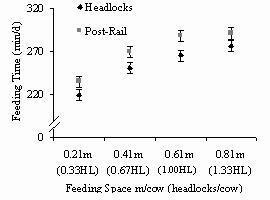Juliana Huzzey, Trevor DeVries and Marina von Keyserlingk
Dairy cattle housed in free stall barns are normally separated from the feed delivery area by some sort of barrier. This barrier is important as it prevents cattle from walking and defecating on the feed. These barriers have been designed to allow cows unrestricted access to feed, however, the management and design of these systems may affect the ability of cows to access feed.
One particular management factor that can influence the ability of cows to access feed is the amount of available feed bunk space. Previous work by our group (see UBC Research Report Vol. 3 No. 3) has shown that increased space allowance per cow at the bunk reduces competition and improves bunk access, particularly for subordinate animals.
Two common feed barriers used in the dairy industry are the headlock and post-and-rail barriers (Figure 1). In a recent study we investigated how the type of feed barrier affects feeding behaviour and the level of competition at the feed bunk. We found that headlocks reduced the frequency of competitive interactions at the feed bunk by 21% compared to the post and rail; this resulted in all cows having more equal access to fresh feed. In a follow-up study, we set out to examine the relationship between feed barrier design and the amount of available space at the feed bunk.
In this study 36 lactating Holstein cows were divided into four groups. Two groups were assigned to pens with headlock barriers and two groups to pens with post-and-rail barriers.

Figure 1. Picture of a headlock (A) and post-and-rail (B) feed barrier.
Each group was then exposed to four feed bunk space treatments (0.21, 0.41, 0.61 (industry standard), and 0.81 m/cow, corresponding to 0.33, 0.67, 1.00, and 1.33 headlocks/cow), in four successive 10-d treatment periods. After these periods, the barriers were switched between groups and the four bunk space treatments were repeated.
Our results showed that when cows were provided with more space at the feed bunk they spent more time feeding per day (Figure 2). Even though 0.61 m (2 ft) of linear bunk space has traditionally been regarded by the dairy industry as adequate, the results of this study, supported by other studies completed by our group, indicate that feeding time would likely increase if cows were provided with more than 0.61 m of space per cow.

Figure 2. Average daily feeding time per cow at four different feed bunk space treatments when provided either a headlock (HL) or a post-and-rail feed barrier.
In addition, cows housed with the post-and-rail feed barrier fed on average 18 minutes longer per day than cows housed with the headlock system (Figure 2). This could be due to cows finding the post-and-rail more comfortable while feeding as there was less hardware separating them from the feed and from adjacent animals. Alternatively, cows may have a learned aversion to the headlock barrier, as this system is often used to restrain animals during uncomfortable procedures such as herd health or artificial insemination.
We found that reduced space availability increased the number of aggressive interactions, particularly at the 0.21 m/cow treatment (Figure 3). On average there was a 134% increase in the number of aggressive interactions (displacements) when cows went from the most bunk space (0.81 m/cow) to the least bunk space (0.21 m/cow). Further, aggressive interactions at the feed bunk were more frequent when using the post-and-rail barrier, suggesting that the headlocks provide some protection against competitive interactions at the feed bunk.

Figure 3. Average daily number of displacements per cow at four different feed space treatments when provided either a headlock (HL) or post-and-rail feed barrier. A displacement was recorded when a cow physically forced another cow from the feed bunk.
In conclusion, we recommend avoiding overstocking at the feed bunk to reduce competition and thus improve access to feed. Further, the use of a barrier that provides some physical separation between adjacent cows can further reduce competition at the feed bunk, particularly for subordinate animals. Future work by our group will focus on determining the long-term effects of overstocking and competition on measures such as DMI, milk production, claw health, and disease incidence.
The results discussed in this report are a summary of research completed by the authors in collaboration with Paul Valois, Marcia Endres, and Dan Weary of the UBC Animal Welfare Program (Endres et al. 2005. J. Dairy Sci. 88:2377-2380; Huzzey et al. 2006. J. Dairy Sc. 89:126-133).
Special thanks to the staff of the UBC Dairy Education and Research Centre. We also thank Nicole Fenwick for her help in preparing this research report. This research was funded by the Dairy Farmers of Canada, the BC Dairy Foundation, NSERC and the many others listed at the Animal Welfare Program.
